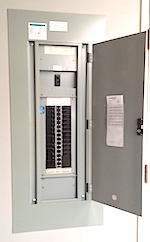We use cookies on this site to enhance your experience.
By selecting “Accept” and continuing to use this website, you consent to the use of cookies.
Physics and Computer Science is committed to safety for our students, staff and faculty. Students are expected to act in a responsible and professional manner in the lab. Safety instructions specific to a course or to the lab component of a course will be discussed in the first lab of the term for every course. Additional safety instructions specific to equipment in a particular lab will be discussed by the lab coordinator as required throughout the course. You are responsible for knowing and following all safety procedures. If you have questions about a lab exercise or situation, such as how to use a particular piece of equipment, ask the instructional assistant or the lab coordinator.
Please notify the lab coordinator as early in the term as possible if there are special circumstances (e.g. allergies, pregnancy, colour blindness) that might make working in the lab, or responding to emergencies (e.g. evacuating the building), difficult for you.
No student may work alone in any Physics or Computer Science lab. For more information on university policy on working alone, see University Policy 7.15.
These electrical emergency procedures are specific to the Physics and Computer Science undergraduate electronics, physics, and optics laboratories.
Top photo: Lab bench power panel
From left to right: AC outlets, Internet jacks, DC power supply and ground plugs (various voltages), DC power switch, AC outlets.

 Right photo (top): Closed breaker panel
Right photo (top): Closed breaker panel
Right photo (bottom): Open breaker panel; main breaker is lone switch on top, in middle.
The DC power supplies at each workbench can be turned off by the DC power switch on the lab bench power panel.
The AC outlets on the bench can only be turned off from the circuit breaker panel. The main breaker in the breaker panel turns off the power to the entire lab. Each lab has its own breaker panel.
When dealing with any electrical hazard, any possible contact with metal objects must be avoided. Never touch any metal near the site of an electrical hazard involving smoke, fire or sparks.

In the instructions below, an action can be performed safely if it can be done without coming into contact with fire, sparks, or any metal near the site of the hazard.
If time permits:
Fire extinguishers in the labs are good for electrical, flammable liquid, and paper fires. The fire extinguishers are always located by one of the doors to the hallway. Portable extinguishers contain only enough material for 8 - 45 seconds, depending on their size. Do not attempt to extinguish a fire using a fire extinguisher unless you can do so safely. Never use water on electrical fires.
If at any time the fire becomes uncontrollable (size of a basketball), activate the fire alarm and leave the building by the nearest safe emergency exit.
Any use of a fire extinguisher must be reported immediately to Physical Resources at 519.884.0710 x6280, so the extinguisher can be recharged or replaced.
Contact Us:
Abdul-Rahman Mawlood-Yunis, Chair
E:
amawloodyunis@wlu.ca
Office Location: Science Building, N2078A
Alexei Kaltchenko, Associate Chair
Danielle Ludwick, Office Administrative Coordinator
E:
pcs@wlu.ca
Office Location: Science Building, N2078
Julia Nguyen, Office Administrative Assistant
E:
thnguyen@wlu.ca
Office Location: Science Building, N2078
Francesca Frias, Office Administrative Assistant (Brantford Campus)
E:
ffrias@wlu.ca
Office Location: One Market Building, OM117
Bernard Chiu, Department Graduate Officer (Waterloo)
Saiqa Aleem, Program Coordinator, Software engineering, Milton Campus
Usama Mir, Program Coordinator (Brantford)